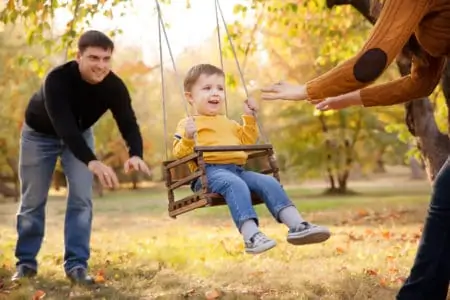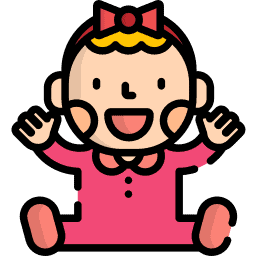If your new baby is hard to soothe, you’re probably looking forward to the day you can lay them in a swing and rest your arms for a few moments. But at what age is it safe for your baby to use a baby swing?
We know the struggle of trying to research while holding a fussy baby, so we’ve compiled all the answers to your indoor and outdoor baby swing age limit questions. You’ll soon be on your way to that much-needed rest — for your baby and your arms.
Key Takeaways
- Age limits for baby swings vary by model, so check the manufacturer’s guide for weight and age recommendations.
- For babies younger than 4 months, use the most reclined position to prevent suffocation.
- Avoid letting your baby sleep in a swing, as it does not meet safe sleep standards.
- Limit baby swing use to less than an hour per day and always supervise your baby while in the swing.
At What Age Can You Use a Baby Swing?
Since indoor baby swings come in a wide range of styles, they vary in their age and weight limits. There are several important factors to consider, such as the swing’s incline, head support, and speed.
To determine the best age to start using yours, you’ll need to check your swing’s instructions. If you no longer have the instruction manual for your baby swing model, you can search for and download a copy online.
Many baby swings can be used immediately after birth. However, the American Academy of Pediatrics maintains that babies younger than 4 months should always be seated in the swing’s most reclined position to prevent suffocation (1).
At What Age Should Baby Stop Using a Swing?
Like all good things, the use of your indoor baby swing will eventually come to a sorrowful end. In most cases, age is a lesser consideration than the weight and ability of your child.
Just as you need to consult the swing’s manual for the best age to begin using your baby swing, you’ll also need to do the same for its limits.
The average motorized baby swing maxes out at 30 pounds. Some styles can only be used for babies under 20 pounds, and others can support up to 40 pounds. This is something to consider when shopping for a new baby swing, especially if, like me, you tend to produce chunky monkeys.
However, if your little one hasn’t reached the maximum weight recommendation but no longer seems to enjoy being in the baby swing, it’s probably time to ditch it.
Likewise, if you have a little escape artist who is attempting to climb out before they reach the swing’s weight limit, it would be wise to pack it away early to avoid injury.
Can Babies Sleep in a Swing?
According to recommendations from the American Academy of Pediatrics, babies should always be placed flat on their backs for sleeping. They should only sleep on a firm safety-approved mattress with no bedding besides a fitted sheet (2).
There is a higher rate of oxygen deprivation (asphyxiation) when babies are allowed to sleep in baby swings or other sitting or carrying devices (3).
My third baby was a party animal. I’m pretty sure his FOMO started in the womb. The only way I could get him to sleep was to spend hours rocking him, bouncing him, or wearing him in a baby carrier.
The first time he tried a baby swing, he fell asleep within minutes. I was thrilled! However, I quickly learned that because baby swings do not fully recline and usually contain soft padding, they don’t meet safe sleep standards.
I knew I would rather have my baby be safe than face any unnecessary risk. So instead of letting him sleep in the swing, I allowed it to lull him to sleep, then carefully moved him to his crib. Although he would sometimes wake up and need to be settled again, it felt good to know I was protecting my son.
How Long Can Baby Stay in a Swing?
With your hands-free and your baby happily occupied, it’s easy to get caught up in trying to accomplish as much as possible. Before you know it, 45 minutes have passed and your baby is still contentedly swaying. How much of a good thing is too much?
Although there are no definitive guidelines, experts recommend that babies spend less than an hour per day in a baby swing (4). Shorter sessions of less than thirty minutes at a time are best.
Spending too much time in infant devices such as baby swings, car seats, or bouncers can contribute to plagiocephaly, a flattening of the baby’s head (5). In an upright device, a baby’s head doesn’t receive the full range of motion it does in other positions. Over time, this can cause the baby’s malleable skull to flatten.
Time spent reclined in a baby swing means time not spent in other essential positions, like on the tummy, sitting upright, or being held by caregivers. This can make it harder for your baby to reach developmental milestones such as sitting up, crawling, standing, or walking.
Using the baby swing as a temporary means of rest and enjoyment is totally acceptable. By keeping your baby’s swing time-limited, you’ll protect them from unnecessary danger and prevent them from tiring of the activity.
Baby Swing Safety Tips
Baby swings can be a mom’s best friend — a few moments of respite from the demands of a fussy baby. They can be a baby’s best friend, too — a calming, womblike experience to help them settle down and unwind. But that best friend can quickly become an enemy if we aren’t careful.
Thousands of babies are injured every year in baby swings, and some of these injuries are fatal (6). We’ve compiled a list of safety tips to help you avoid unnecessary danger.
- Shop for swings with high safety ratings.
- If your swing was previously used, check that it has not expired and confirm that there have been no recalls on it using the CPSC Recall List.
- If your swing is new, register it with the manufacturer so you can be notified if there are any recalls.
- Follow the manufacturer’s instructions when setting up your baby swing. Ensure that all pieces are present and securely fastened.
- Test swing parts regularly.
- Never place a baby swing on a raised surface such as a table.
- Adhere to the size and weight recommendations for your swing model.
- Always fasten the safety harness securely, ensuring it doesn’t interfere with your baby’s breathing.
- For babies younger than 4 months, recline the swing as far as possible.
- Start with the lowest setting and work your way up, according to your baby’s liking.
- Always supervise your baby the entire time they are in the swing.
- Don’t lift or move the swing while your baby is seated in it.
- Don’t allow other children to play near or with the swing.
- If your baby falls asleep in the swing, promptly move them to their bed.
- Use your baby swing for short periods (ideally, less than 30 minutes at a time and less than 1 hour total per day).
- Stop using the swing if your baby is regularly unhappy in it or attempts to climb out.
This list may look long, but most of these recommendations take only moments to follow. Every second is worth it if it protects your child from harm.
When Can My Baby Go on a Park Swing?
Around the same time, your baby is transitioning out of their beloved swing, they may be ready to try an outdoor bucket-style swing. Playground swings are different from indoor baby swings. There are a few things you’ll want to consider before your baby’s first glide.
In roomy park swings, babies are seated in an upright position. They need to have enough strength in their back and neck to sit upright without support. Flopping forward and back with the motion of the swing is uncomfortable and could potentially cause a neck injury.
Some babies are ready for park swings by 6 months of age, but most are not ready until at least 8 or 9 months. Be playful but cautious the first time you let your child try an outdoor baby swing. Your baby may feel uncertain about the change, but most adjust quickly when they realize how fun it can be.
Babies or toddlers with low muscle tone (hypotonia) or hypermobile joints may find it difficult to hold their head or body upright in a playground swing. If this is the case, you may need to wait until they are older or find a playground with a reclined accessible swing.
If your baby does not enjoy park swings, give it time. Encourage them to try, but if they’re unhappy, don’t push it. There are plenty of other fun experiences they can enjoy outdoors.
Baby Swing FAQs
These often-asked baby swing questions may give you the answers you’re seeking.
Know Your Limits
Swings can be an enjoyable and calming pastime for people of all ages. Since there are no specific age limits for baby swings, ensure your baby is developmentally ready and doesn’t weigh more than what your swing can handle.
Remember that swings are made to be used for downtime, but never for sleeping. Most importantly, always supervise your baby when using the swing so you can be available at a moment’s notice.









